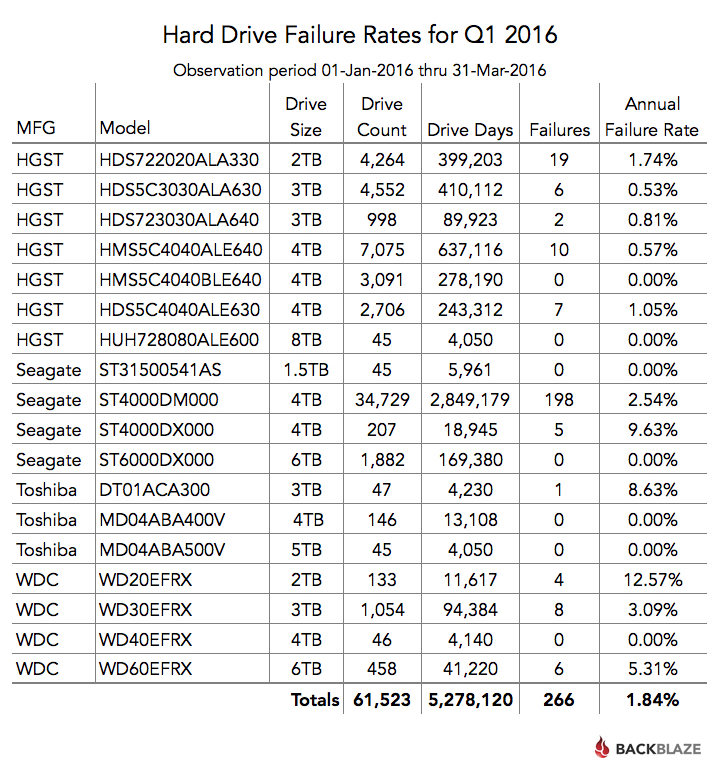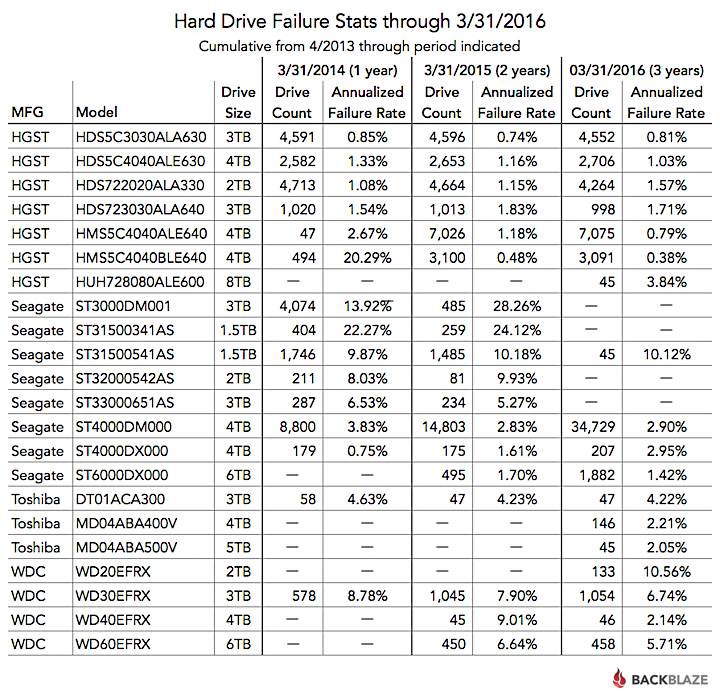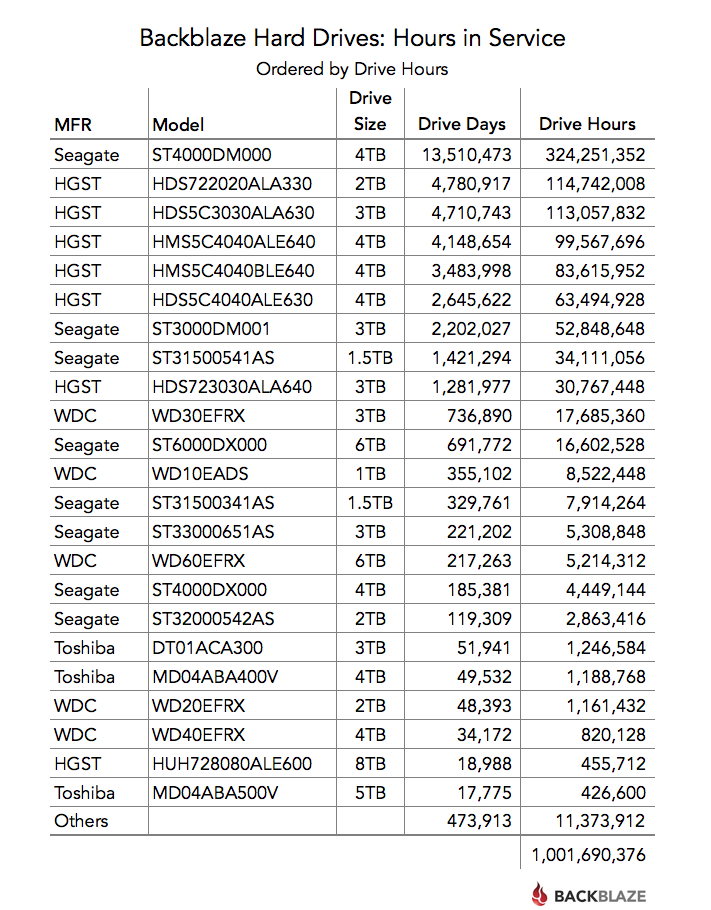What is RAM?
Random Access Memory (RAM) is one of the most purchased computer components in the world. The constant updates of computer software keep this industry on its toes.
RAM is a volatile computer memory that deletes all information stored on it after the computer is turned off.
New generations of computer desktop and laptop memory are introduced in the market from time to time. However, they’re not really interchangeable. Therefore, it is essential for you to check the requirement of your computer before going online on a computer memory hunt.
The Trick That Works, Always!
We have compiled a few tips that will help you in buying the right computer memory, laptop memory, desktop memory and server memory for your needs.
* Find out how much RAM memory do you require *
Ram Memory
There are many factors that affect a computer desktop memory. One of the major factors is the personality of the user. Many users stick to one task while they are on computer systems while others go for multi-tasking. For both these personalities, the computer RAM requirements will be different. So, to buy the optimum amount of RAM module for your computer system, you need to check what type of programs you run.
* How much memory do I need? *
The more RAM a computing device has, the faster it runs. If your device is old, you might need to upgrade the hardware. Every open application (including tabs in a web browser) consumes RAM. You can run out — and when that happens, the computer has to move things around on the hard disk, which slows down the computer.
Note that RAM is different from storage: if you turn off your PC, the information is gone whereas on storage (SSDs, HDDs…) that data will be saved.
How much RAM do you need? It depends on the kind of work you do, how many things you do at once, and how impatient you are. As with so many other parts of computing, we always want our devices to respond instantly!
In most circumstances, however, you need far less RAM than you do hard disk space. Again, think of that physical office desk. The more space you have on the desktop, the more pieces of paper you can spread around. But that doesn’t keep you from wanting a very big file cabinet for long-term storage of all the files you’ve collected over time.
* Check the configuration of your computer RAM *
Computer memory configuration is available in the BIOS menu of your computer system. Or an easy way to check computer memory configuration is by installing and running a program named CPU-Z.
Search for the RAM memory stick at local stores and online
As the new generation of computer memories are introduced in the market, old ones are removed. It may be possible that the RAM you need is not available at local stores. There’s nothing to despair yet; there’s a high chance you’ll be able to find what you are looking for in the online world.
Hard to Find Computer Memory
Memory4less.com has a reputation for stocking computer memory older than ten years. We’ll swoop in to save your world from crumbling if you’re trying to revive an old computer. Besides that, our prices will keep you coming back for more.
* Buy computer RAM online and Install in your PC *
If you are buying computer memory online, choose a ram memory selling website that is trusted and has good reviews. Make sure you get a realistic delivery time for your products; you don’t want to be stranded in the middle of nowhere while your best gadget awaits its soul!
Open the back cover
Install computer RAM
Check configuration through BIOS – it should now reflect the updated RAM module capacity
Test the computer RAM module through software – if it still doesn’t work properly, you might want to call the customer support.
Buy Server Memory :https://www.etechbuy.com/category/memory/server-memory.html
Buy Laptop Memory :https://www.etechbuy.com/category/memory/laptop-memory.html
Buy Desktop Memory :https://www.etechbuy.com/category/memory/desktop-memory.html
Buy Gaming Memory :https://www.etechbuy.com/category/memory/gaming-memory.html
#WhatIsRAM #BuycomputerRAMOnline #HardToFindRAM
Search This Blog
Followers
Friday, February 28, 2020
What is RAM? Buy computer RAM Online Read These Crucial Tips Before Buying Computer Memory Online.
Posted by
Computer Peripheral Devices Connects
at
3:29 AM
0
comments
![]()
Wednesday, May 31, 2017
Find the right part for your system in 3 easy steps!
Build your next system through easy to use Memory4Less Configurator
Ultimate Configurator
Posted by
Computer Peripheral Devices Connects
at
4:52 AM
0
comments
![]()
Wednesday, March 1, 2017
Best Seagate Hard Drives at Memory4Less.com
Get Seagate Hard Disk Drives for Reliable Data Storage
One Billion Drive Hours and Counting: Q1 2016 Hard Drive Stats
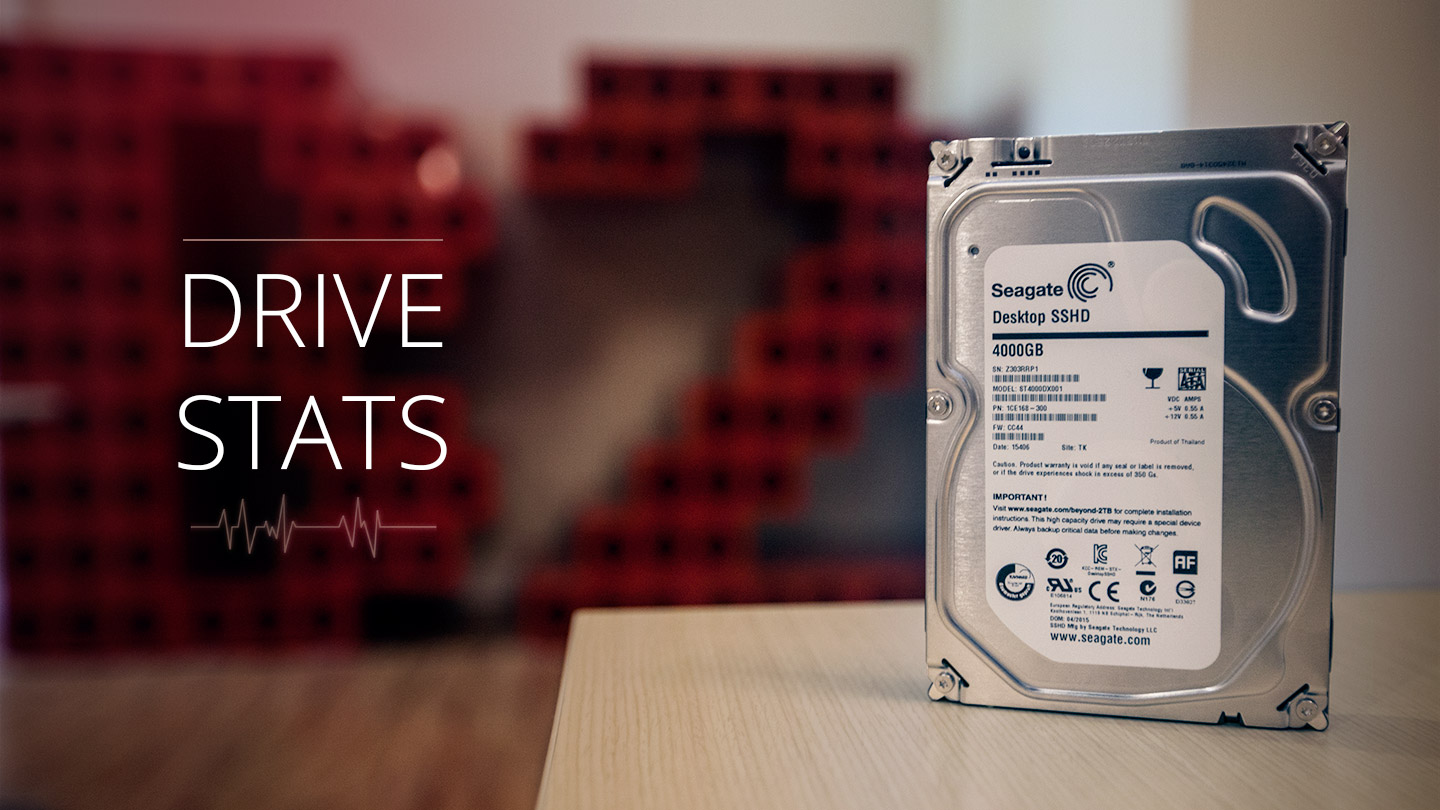
Backblaze hard drive reliability for Q1 2016
- The list totals 61,523 hard drives, not 61,590 noted above. We don’t list drive models in this chart of which we have less than 45 drives.
- Several models have an annual failure rate of 0.00%. They had zero hard drive failures in Q1 2016.
- Failure rates with a small number of failures can be misleading. For example, the 8.65% failure rate of the Toshiba 3TB drives is based on one failure. That’s not enough data to make a decision.
- The overall Annual Failure Rate of 1.84% is the lowest quarterly number we’ve ever seen.
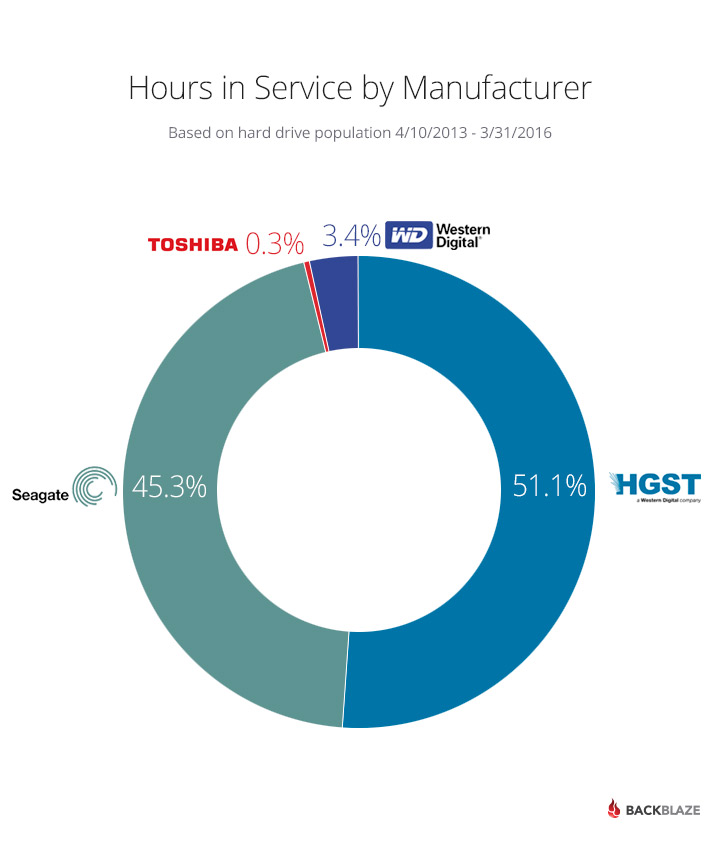
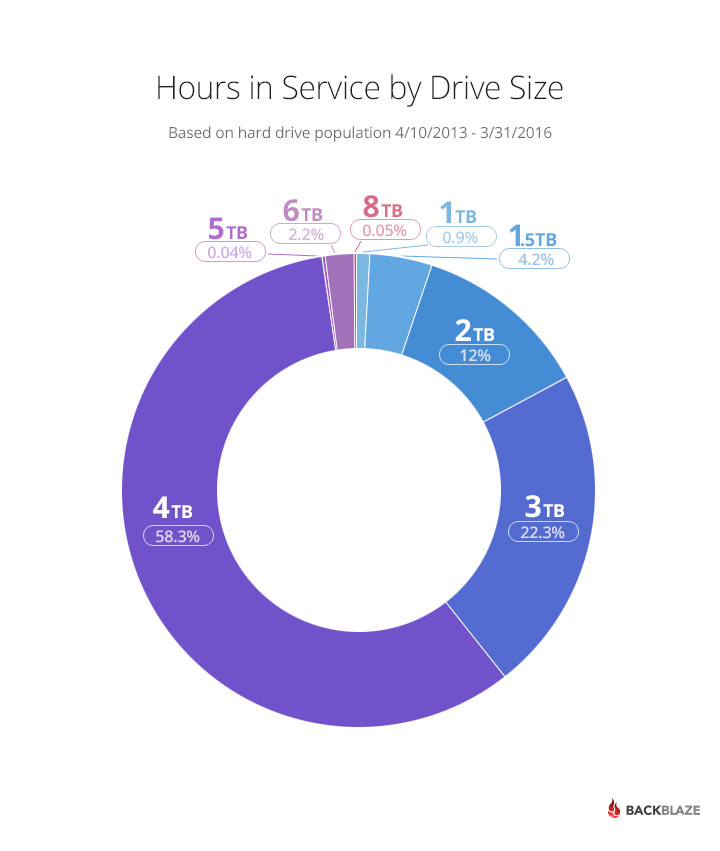
Hard Drive Reliability by Manufacturer
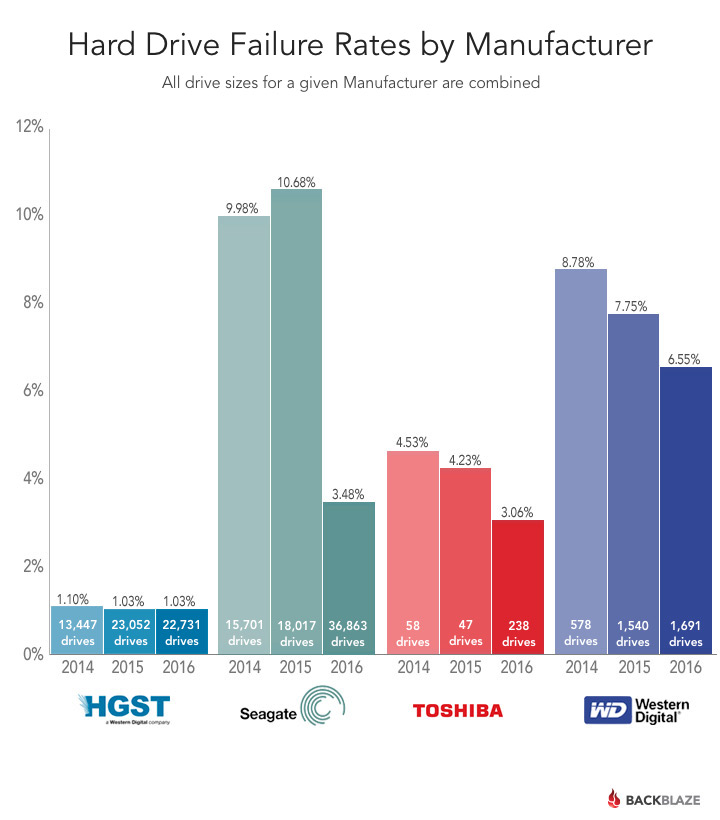
- We once had 45 or more drives, but some failed and we couldn’t get replacements of that model and now we have less than 45.
- They were sent to us as part of our Drive Farming efforts a few years back and we only got a few of a given model. We needed drives and while we liked using the same model, we utilized what we had.
- We built a few Frankenpods that contained drives that were the same size in terabytes but had different models and manufacturers. We kept all the drives in a RAID array the same model, but there could be different models in each of the 3 RAID arrays in a given Frankenpod.
What is a failed hard drive?
- The drive will not spin up or connect to the OS.
- The drive will not sync, or stay synced, in a RAID Array (see note below).
- The Smart Stats we use show values above our thresholds.
Posted by
Computer Peripheral Devices Connects
at
4:24 AM
2
comments
![]()
Wednesday, October 28, 2015
Make every conversion count: cross-device data now included in the Conversions column and integrated with automated bidding
Make every conversion count: cross-device data now included in the Conversions column and integrated with automated bidding
Starting today, cross-device conversions will begin rolling out at the keyword-level and can be included in the main Conversions column that already includes website sales, phone calls and app downloads. By showing all conversions in one place, advertisers can get deeper insight into all the ways customers are engaging with their businesses. It’s also easier than ever to take action on these insights: with all of your conversions in the same column, you can quickly enable automated bidding to optimize for the conversions that matter.
To activate cross-device conversions in automated bidding, complete two easy steps in your AdWords account under Tools>Conversions:
- Under Settings, make sure the Conversion bid metric is set to “Conversions” instead of “Converted clicks.” As a reminder, cross-device conversions and other controls are not offered for “Converted clicks”.
- Click “Include advanced conversions” and check the box to include cross-device and other advanced conversions in your “Conversions” reporting column and automated bidding.
Posted by Wilfred Yeung, Senior Product Manager, AdWords Bidding
1 The Role of Mobile Search on Store Purchases, Google/Ipsos Media CT, August 2015. Purchases were made within the past 3 months.
Posted by
Computer Peripheral Devices Connects
at
1:57 AM
1 comments
![]()
Thursday, February 18, 2010
Yahoo! and Microsoft Receive US and EU Clearance to Implement Search Alliance - Web Hosting Industry News | Daily Web Hosting News and Web Host Interviews"
Posted by
Computer Peripheral Devices Connects
at
12:31 PM
0
comments
![]()
Thursday, January 21, 2010
Yahoo! Search Marketing Blog » You’re in Control
Yahoo! Search Marketing Blog » You’re in Control
You’re in Control
Network distribution and import campaigns features give greater control over your campaigns
We resolved to deliver to our Sponsored Search advertisers two great new features in the new year: network distribution control and an import campaigns tool. These items may have been on your wish list for a long time, and as of today, the wait is over. Here are the details:
Network Distribution
This new feature enables you to set up campaigns or ad groups targeting Yahoo! Search, Yahoo! Partners, or both.
If you select Yahoo! Search, your ads will appear only on Yahoo! search results pages. If you select Yahoo! Partners, your ads will appear across our partners’ pages, including WebMD, Buy.com, CNBC and CitySearch.
With the network distribution feature, you can choose for your ads to appear only on Yahoo! search results pages, only on Yahoo! partner implementations, or across the entire network. Even if you choose to target a campaign or an ad group to the Entire Network (i.e., both Yahoo! Search and Yahoo! Partners), you have the ability to fine-tune your bids with different bids for Yahoo! Partners.
If you’re familiar with our system of pricing discounts, you know that your clicks are automatically priced according to our assessment of the performance of traffic coming from various sources within our distribution network.
While your campaign objectives will determine the best use of network distribution, we recommend that advertisers target the Entire Network to maximize traffic volume, while retaining the ability to bid up or down on Yahoo! Partners. For more control and optimization capability, you may wish to duplicate key campaigns, with one targeting Yahoo! Search and the other targeting Yahoo! Partners.
The following tools can help you get the most out of this new feature:
- Network Distribution Performance Report – Enables you to view reporting by traffic source at the campaign, ad group and keyword levels.
- Ad Delivery Report – Provides insight into where your ads are showing on our various partners’ sites, and domain-level performance.
- Blocked Domains – Block up to 500 domains that aren’t working for you.
- Conversion-only Analytics – Allows you to track conversion events by domain, and record revenue that might be associated with a transaction.
Import Campaigns
This new tool is designed to help you easily and efficiently convert your campaign data from Google AdWords into Yahoo! Search Marketing formats. Simply download your third-party file, then import it from your computer into the Sponsored Search interface. You can import your file by selecting the “Import Campaigns” button, which is located on the Dashboard and the Campaigns tabs, or by selecting the Import tab.
Once the import is complete, you’ll be able to view any errors and pause the campaigns for review. Learn more about converting and importing your third-party campaign data.
Posted by
Computer Peripheral Devices Connects
at
2:24 AM
1 comments
![]()
Thursday, October 8, 2009
Yahoo! Search Marketing Blog » The Next Wave of Search
Yahoo! Search Marketing Blog » The Next Wave of Search: "The Next Wave of Search
Yahoo! Search Advertising Enhancements That Deliver
With all of the events that Yahoo! has gone through in the last several months, one of the questions I get is: “Does Yahoo! still care about search?” The answer is: Absolutely. In fact, Yahoo! is delivering a series of enhancements that deliver value to consumers and advertisers alike.
Our new search enhancements fall into four major areas: innovation, transparency and control, value, and consumer relevance.
Innovation
Only Yahoo! can combine the power of search and display to provide great value to our advertisers. Our search retargeting and Rich Ads in Search products are great examples of just that. Our initial testing suggests that Rich Ads in Search can help improve click-through rate by as much as 25%, and some advertisers have even more impressive results.
Later this month, we’ll build on the success of Rich Ads in Search and let some of our large brand advertisers bid for Rich Ads placement and pay by the click. Those advertisers will be able to manage Rich Ads and their budgeting, targeting and reporting directly from the Sponsored Search interface and our APIs.
Transparency and Control
You want to be in control of your ad campaigns. You want to know where your ads are showing, and you want better tools to manage them. That is why we just rolled out the Ad Delivery Report, which lets you see where your ads are showing on our various partner sites and how their traffic is performing for you. You can use our Blocked Domains feature to block sites that aren’t working for you.
You’ll have even more powerful tools to control where your ads show with Network Distribution. Network Distribution will let you run your ads on either Yahoo! or its partner network, and set bids separately for each channel. We expect to launch Network Distribution in the first quarter of next year.
Also next year, you’ll be able to get a look at our Yahoo! Search Marketing Desktop tool, an offline tool designed to help sophisticated search advertisers create and manage large campaigns. The tool will help you complete search advertising tasks easier and more quickly. If you’re interested in it now, please contact your account representative or sign up to inquire about our beta program.
Value
We know it’s all about value and results so we want you to get the most out of your investment. That is why we recently adjusted our pricing model to better align what you pay with the value of the clicks you receive. And we keep going. Later this year, you’ll see enhancements to our ad selection technology that are designed to improve the way ads get matched to consumer queries. Better matching means better results, and should lead to better return for you.
Consumer relevance
More personally relevant searches translate into more qualified leads for advertisers. Our new search results page gives users tools to discover new information, explore related concepts, and filter search results by specific sites and types of content such as people, videos and discussion forums.
We are also creating search that learns. Using search science that detects user intent by studying search behavior over time, our search technology is designed to better understand what people are searching for by looking at their previous searches.
If you haven’t noticed, our new marketing campaign puts the consumer at the center of everything Yahoo! does, and we’re backing that up by investing heavily in the consumer experience. Our success is tied to attracting more engaged consumers who, in turn, search more frequently. And that’s good news for you."
Posted by
Computer Peripheral Devices Connects
at
5:00 AM
0
comments
![]()
Friday, September 11, 2009
Yahoo! Search Marketing Blog » Do You Know Where Your Ads Are?
Yahoo! Search Marketing Blog » Do You Know Where Your Ads Are?:
"Do You Know Where Your Ads Are?
New feature helps you see how your traffic performs
Would you like to know where your ads are running? Yahoo! is launching some new features that will let you know which Yahoo! partners are providing you traffic, and charge you according to the performance of the traffic you receive.
There you are
You probably know that your ads can appear not only on Yahoo, but on partners throughout our distribution network, and that you can block them if they’re not performing for you. But until now, if you didn’t have a pretty good head for web measurement stuff, you probably didn’t know which traffic sources were working for you. Now our Ad Delivery Report will let you see how your ads are performing on various partners, and use that information to block the partners who don’t give you what you need.
The Ad Delivery Report shows you not only your traffic sources—whether that be Yahoo! or some of our partners—but also how your traffic from those sources converts. Combined with one of our analytics options, you can track measurements such as impressions, click-throughs, conversions and return on ad spend. You can also filter the results by account, domain, distribution channel and tactic.
If you find traffic sources that you don’t want, you can enter the domains in our Blocked Domains tool. Keep in mind that you can block a maximum of 500 domains, so pick the domains that are most important for you to block based on the amount and performance of traffic. Make sure you’re getting enough traffic on those domains to make informed decisions about their performance, and keep in mind that when you block domains you reduce the traffic you’re likely to receive, too.
You can get started with the Ad Delivery Report by clicking on the “Reports” tab in the Sponsored Search interface, or learn more about how to use it in our help center.
Pay for what you get
As you’ll see when you start looking at your Ad Delivery Report, not every partner will perform the same for you. We’ve discounted our click charges accordingly for some time now. We’re now expanding the adjustments we make to our click charges based on our assessment of the performance of traffic coming from sources within our distribution network.
This will include deeper discounts on click charges for lower-performing traffic, and potential premiums on click charges for higher-performing traffic—in other words, your click charges will be more closely aligned to the performance of the traffic you receive.
How does it affect you? Based on our analysis, we expect that most advertisers will see click charges drop or remain unchanged, while a small fraction of advertisers may experience an increase in click charges. These adjustments are based on the performance of the traffic source, and won’t be affected by the quality of your ads. And, as always, you will never pay more for a click than the amount you set as your bid.
Now in a town near you
Sponsored Search has several new features that let you manage your billing and account information more easily. You can now edit your payment methods more simply, such as when you want to swap a credit card out for another, and more easily set an appropriate automatic charge amount to fund your account when your balance gets low. If you’ve just signed up with us using a promotional code, the system will let you see which credits are being applied to your account, along with their status. For more details about these changes, see what’s new in Sponsored Search.
We’ve also updated our geographic targeting feature. It already let you get specific in your campaigns by allowing targeting down to the city or ZIP code levels, and it’s now even more specific with the addition of 746 new cities. So, if you were dying to target the good folks of Beverly Hills, Calif. or San Benito, Texas, today is your lucky day."
Posted by
Computer Peripheral Devices Connects
at
12:14 AM
0
comments
![]()
Thursday, August 20, 2009
Free & CPC Shopping Site Comparison
Free & CPC Shopping Site Comparison:
Compare both free and CPC based price comparison websites
Free Product Comparison Sites:
Google Shopping
Live Products
MSN Shopping
Price.com
TheFind.com
CPC Shopping Engines:
About.com Shopping
Amazon
AOL Shopping
Ask Shopping
Bizrate
DealTime
Excite Shopping
Lycos Shopping
MySimon
NexTag.com
PriceGrabber.com
PriceRunner
PriceScan
Pronto.com
Shopping.com
Shopzilla
Yahoo Shopping
Product search engines (also known as product comparison engines, price comparison engines & shopping engines) offer a new way for web users to find the products they are looking for. When a person visits a product search engine they are able search products by price, store & store ratings allowing visitors to easily compare products. Each product in a search result usually includes an image, description, price and a link to buy from the advertiser’s website.
Shopping Search Engines can be free of cost to retailers or charge stores on a cost per click basis. As with PPC ads, CPC Shopping sites can get quite pricey and lower profit margins drastically. Businesses should take advantage of all the Product Search Engines which are free of cost. Why list in one price comparison engine when you could list in all of them for no cost allowing retailers reaching out to more people. All these shopping"sites are great for consumers but which ones are better for retailers? With numerous shopping engines available on the web, how do you choose the right one for your products? Below is a list of popular product comparison engines, their fees and services offered to retailers/advertisers.
Product Search Engines Offering Free Retailer Listings
Google Shopping – Google offers a free product listing to e-retailers. Retailers can upload a feed of their products or input product information individually including image URL, product URL, price and various other product specifics. Google Shopping visitors can sort products by relevance of their search terms, price, brand names, product ratings and store ratings. Products listed in this free price comparison engine expire after 31 days.
Live Products – Live, a Microsoft Corporation website also offers e-stores free product listings. Advertisers can upload their product information manually or in bulk via their FTP. Visitors of Live Products can search by product brand, category & price range. When visitors find the product they are looking for they then click to compare prices, which brings up a list of retailers and the product price for each. Visitors can click on the retailer they are interested in buying from and are brought to their website to purchase. This Product Comparison site offers visitors the ability to quickly and easily compare prices from different retailers. Items listed in Live Products expire after 30 days.
MSN Shopping –An affiliate website of Live Products offers retailers free product listings. MSN Shopping products are submitted and updated through Live Products. Visitors of this Shopping Comparison Engine can filter results by category, brand, seller and price range. They can also sort their results by price, ratings and alphabetically.
Price.com – Price.com offers e-stores the ability to list their products free of cost. When a visitor searches this price comparison engine for a product they are given a list of items along with images. When a visitor clicks on the product they are interested in they are given a list of stores, the store rating and their corresponding prices. When a visitor finds the store they want to buy from and click on the name they are brought to that advertiser’s website to purchase.
TheFind.com – E-stores can add their products with ease and free of cost to TheFind.com. When searching for a product visitors are offered the choice of filtering results by brands and stores. After finding the product they are looking for they are given all the product results with prices and store names and are listed in no particular order. Once a searcher finds the product and price they click on that store and are brought to their website. Retailers submit their products and this price comparison engine will crawl their website to constantly update product listings.
Shopping Search Engines with Cost Per Click Retailer Listings
About.com Shopping – Products are listed on this price comparison engine for a cpc basis which is powered by PriceGrabber.com. Retailers interested in being listed on About.com need to submit their information to PriceGrabber.com. Visitors of this shopping site find the product they are looking for and click on compare prices to view prices of all listed e-stores.
Amazon.com – Amazon.com allows retailers to list their products for a fee of $39.99 per month. In addition to this shopping search engines listing fee, retailers also have to pay Amazon a percentage of sales. Percentages paid by retailers are dependent on the type of products they sell. The obvious advantage of Amazon is the mass amount of traffic it receives, but in many cases the costs of listing outweigh profits. When visitors search for products they are offered an assortment of filter options to find the product that best suits them. E-stores can upload their products either one at a time or in bulk.
AOL Shopping – The popular website AOL, has a shopping comparison site which is also powered by PriceGrabber.com. AOL Shopping allows visitors the ability to filter searches by brand and price range. These filter options allow users to locate the product they want quicker and compare retailers easier than most other product comparison websites. Retailers wishing to be listed on this price comparison site should submit their data through PriceGrabber.com.
Ask Shopping – This product comparison site is powered by Pronto.com. Retailers can submit their product listings in bulk to Pronto.com and pay on a cpc basis. When visitors find the product they want they are given a list of retailers and their corresponding price. Clicking on a price will bring you to that retailer’s website and they will then be charged a cpc fee.
Bizrate – This product comparison site is an affiliate of Shopzilla. All listed products were uploaded in bulk through Shopzilla. Bizrate has the same filters and listing practices as its shopping comparison affiliate, Shopzilla.
DealTime – Part of the Shopping.com network, DealTime allows retailers to list their products on a cpc basis. Retailers wishing to be listed on this shopping comparison engine can upload their data through Shopping.com. This price comparison website offers the same search filters as most other shopping engines.
Excite Shopping – Products on this comparison site are listed on a cpc basis and are submitted via Pronto.com. This shopping engine offers the similar search filters as other comparison sites, including: price, brand and merchant. Stores which carry the searched product are listed along with their prices and when clicked on visitors are brought to that merchant’s website.
Lycos Shopping – Lycos Shopping is another affiliate of the price comparison site, Pronto.com. Retailers wishing to list their products on this shopping site must submit their data through Pronto.com. Search filters on this price comparison site include: price range, brand, product features and merchants. When a visitor locates a product and a price they like, they click on a price and are brought to that retailers site and that e-store is charged their cpc fee.
MySimon – MySimon is yet another PriceGrabber.com affiliate. Merchants interested in submitting their products should do so through PriceGrabber.com. When a searcher locates the product they are interested in on this shopping site they can compare prices of all e-stores carrying that item, allowing them to locate the best price. After clicking on the best price a visitor is brought to that advertiser’s website.
NexTag.com – Retailers can list their products on this price comparison engine on a cost per click basis. When a searcher clicks on a product the retailer is than charged a fee based on the product being sold. As with PPC, a person can click on an ad go to the retailer’s website and they not buy, costing the e-store money and lowering profit margins. This shopping comparison site accepts bulk product uploads but in order to set up an account be ready to deposit $150.00.
PriceGrabber.com – This product comparison website allows e-stores to list their products for a cost per click fee. When visitors find a product they are given a list of online retailers and their corresponding prices. After the searcher finds the price they want they click the product and are brought to that retailers store and the retailer is charged a small fee. Although the cpc fees are minimal, if they are clicked on numerous times it can become quite expensive. For retailers to list their products in this comparison engine they must deposit $50.00 and upload their data via a bulk feed.
PriceRunner – Retailers are able to list their products at a cpc rate on PriceRunner.com. E-stores can upload their products to this product search engine in bulk. PriceRunner does not offer all the search filters for visitors that other price comparison engines offer. Searchers can only filter results by brands and types. When results are listed they show an image, store name and product price. When a visitor finds the product they are searching for they click the store link and are brought to that e-store.
PriceScan.com –PriceScan.com offers e-stores the ability to list their products on a cost per click basis. Visitors search for a product and are brought to a page with various search matches. Clicking on a product bring visitors of this price comparison site to a listing of retailers along with their prices. When a searcher clicks on the retailer they wish to purchase from they are brought to their website to buy and the retailer is charged a fee. To setup a retailer account with PriceScan, be ready to deposit $50.00.
Pronto.com – E-Stores can list their products on this comparison site on a cost per click basis. The cpc fees paid vary depending on the type of products being listed, but are pretty consistent with other cpc comparison sites. Searchers of this shopping site can filter their search results by price, brand and merchant. After locating the product they want, visitors can compare prices from all retailers listing that item and when choosing a merchant are brought to their website and the merchant is then charged their cost per click fee. Retailers can upload their products in bulk to this product search engine.
Shopping.com – Retailers can list products on this price comparison engine on a cpc basis. Visitors of this popular shopping site can filter product results by price, brand and store. Product searchers can also view reviews of site retailers. When visitors are interested in a product they click on a price and are brought to that merchant’s website and the retailer is charged a fee.
Shopzilla – E-stores wishing to be listed on this price comparison engine pay based on a cost per click fee schedule. Products listed on Shopzilla can be uploaded in bulk and are listed on numerous other affiliate shopping sites. Searches can filter products by brand, price, store and numerous other filters depending on the product. All products which match a category are listed in no particular order and include the store name and their corresponding price.
Yahoo Shopping – CPC pricing is used for retailers wishing to list their products on this very popular shopping engine with fees varying depending on product categories. Retailers can also pay to be a featured merchant and have their products listed on top of searches. Along with the normal search filters, this comparison site offers visitors the ability to compare product listings side by side, allowing them to easily find the best deal.
Even after reviewing the list of shopping search engines you may still be asking yourself “which ones are the best to list in”? Although all of the above comparison sites are popular and get a lot of traffic it is expensive to list in all of them. Aside from listing in all of the free product comparison sites there is no real answer to which of the cpc comparison sites are best to list in. The best way to find the right solutions for your business is to just try them one at a time. By reviewing the cpc comparison site statistics for your account you can tell how many clicks you received and through further reviewing analytics you can track which products were purchased. The comparison site which drives the most traffic to your website and gives you the most purchases is the best solution for a successful e-store.
Posted by
Computer Peripheral Devices Connects
at
11:06 AM
0
comments
![]()
Ad Extensions - Introduction - AdWords Help
Ad Extensions - Introduction - AdWords Help: "Ad Extensions - Introduction
Print
Ad extensions expand a standard text ad with additional business information such as an address, helping web users easily find out more about your business. Ads will appear as normal across Google and the Google Network, but the additional information may also appear on Google.com and its properties, such as Google Maps, in an enhanced format. For example, if you own a bicycle repair shop in downtown Tokyo, a customer near your store searching for bicycle repair shops or tools to repair their bicycle is a local user you could more effectively reach with ad extensions. The user will see your text ad, along with your business information.
Pricing and traffic
You're charged in the same way for ad extensions as you are for a standard text ad. However when your ads are shown on Google Maps, you won't be charged for clicks on your ad that expand the info windows on the map interface, but you will be charged for clickthroughs from the info window to your website.
To learn more about ad pricing in your location and currency, please see the account fees finder.
Where ad extensions appear
Your expanded ads are eligible to appear on Google and its properties (including Google Maps) and the Google Search Network. You can use ad extensions to target multiple locations wi"
Posted by
Computer Peripheral Devices Connects
at
8:22 AM
0
comments
![]()
Wednesday, July 29, 2009
Microsoft, Yahoo agree on long-sought search deal by AP: Yahoo! Tech
Microsoft, Yahoo agree on long-sought search deal by AP: Yahoo! Tech: "SUNNYVALE, Calif. -
Microsoft has reached a deal with Yahoo for an Internet search partnership, ending years of back and forth negotiations.
The agreement announced Wednesday gives Microsoft access to the Internet's second-largest search engine audience.
It adds a potentially potent weapon to Microsoft's Internet arsenal as the software maker girds for an online assault against Google.
Yahoo is teaming with Microsoft following years of financial decay. In the process, Yahoo hopes to recover some of the money that was squandered in 2008 when it turned down a chance to sell the entire company to Microsoft for $47.5 billion.
Microsoft wants to process more search requests because the inquiries have become a critical lever for selling Internet ads."
Posted by
Computer Peripheral Devices Connects
at
5:51 AM
0
comments
![]()
Say Goodbye to the Dell Mini 9" Netbook
Say Goodbye to the Dell Mini 9" Netbook: "Dell announced that the Mini 9 Netbook was officially discontinued after about 9 months on the market. (Hmm.. did they plan that?)
Netbooks are quickly becoming very popular! And why shouldn’t they? They’re great for travel, perfect for bloggers, and an excellent computer option for kids. So, why is Dell discontinuing?
The good news is that Dell did expand their Mini line and they have a few 10 inch options available for you to choose from if Dell is your preferred computer manufacturer. The Dell Mini 10v (pictured here in green) has a starting price of $299.
If you’re still on the fence or undecided you can always refer back to the video comparison of some of the most popular netbooks around."
Posted by
Computer Peripheral Devices Connects
at
3:42 AM
1 comments
![]()
Setting Bids - Yahoo! Search Marketing Help
Setting Bids - Yahoo! Search Marketing Help: "Managing Bids
A bid represents the maximum amount you are willing to pay for a click on your ad. You cost per click, or CPC, is the actual amount you pay for a click. Bidding is a key part of managing your Sponsored Search account. An effective bidding strategy can help you:
* Better manage your bids.
* Allocate your advertising spend to help you receive the maximum amount of targeted traffic.
* Gain a higher return on your advertising spend.
Bidding at two levels
You can bid at two levels:
* keyword
* ad group
* At the ad group level, you set separate bids for Sponsored Search and Content Match campaigns.
* At the keyword level, you can only set a custom bid for that specific Sponsored Search keyword, or use the default bid from the ad group.
For example, if you set a custom bid of $0.50 for a keyword, it will set the bid for that keyword at that price. But if you set the keyword to use the default bid, it will use the bid you set for the ad group.
Bidding Adjustments
Bid adjustments are available for use with your account’s targeting capabilities. This feature allows you to add a premium to your current bid in the form of a dollar amount or a per"
Posted by
Computer Peripheral Devices Connects
at
3:36 AM
0
comments
![]()
Yahoo! Announced Panama Launch : See My Notes About Panama Directly From Yahoo! Search Marketing's Headquarters
Yahoo! Announced Panama Launch : See My Notes About Panama Directly From Yahoo! Search Marketing's Headquarters: "Pricing Model, once cent above the guy below you is what you pay, that is if quality index is equal. If someone is paying $1 and an other is paying $0.75 and then an other is paying $0.60, so if the one bidding $1 is highest quality and the rest are equal, then one bidding $1 will pay $0.61, and one paying $0.75 will pay $0.51 and the one paying $0.60 will pay $0.26."
Posted by
Computer Peripheral Devices Connects
at
3:16 AM
0
comments
![]()
Monday, October 13, 2008
Yahoo! Improve Content Match Performance
Behind the Scenes These subtle changes are designed to lead to better Content Match performance Sometimes a product launch is big, like our recent launch of APT from Yahoo!. And sometimes it's understated, like the improved version of our contextual advertising product, Content Match, which we're announcing this week. It's not a new brand, and it looks virtually the same in the user interface. It just works better—at matching your ads with interested customers and helping you achieve better return on your ad dollars. Better Matching for Higher Click-Through Rates This combination can lead to more relevant clicks. Since we started rolling out the new technology, we've generally seen increases in Content Match click-through rates—and some advertisers have seen those rates climb appreciably. What it does for you can depend on a lot of things, including the keywords you select, the ads you write, and the settings you choose. Improved? Ask these Advertisers Lulu.com, a marketplace for digital content from authors, artists and musicians, has used Yahoo! Search Marketing for more than four years to point users to its services, which include free web storefronts and social networking offerings. Lulu's Director of Search Engine Marketing, Dan London, has used Content Match on and off for the past two years. Recently, he noticed significant improvements to the service, including appreciably lower costs of conversion. "In the last couple of months, I noticed that targeting our users through contextual ads was improving and that we were seeing more clicks at lower costs," he says. "Although we had spent time improving the keywords in our campaigns, we knew that there had to be something more to it. After learning that Yahoo! had made improvements to its matching technology, it's clear that it's been part of what has driven this overall effectiveness." Why Content Match? Content Match has been a great service for Lulu, according to London. "Yahoo!'s Content Match has allowed us the opportunity to reach potential customers who do not turn to search engines to find what they need," he says. What Do I Need to Do? If you've been using Content Match, you may already be noticing a bump. If you're not using it yet and it fits your business, it may be worth a try. — Jeff Sweat Online access: http://www.ysmblog.com/blog/2008/10/10/behind-the-scenes/#comment-609273
We've been gradually moving Content Match to a new matching technology over the past few months. The new technology not only attempts to understand what the content is on a page, but also, who is viewing it, which helps you get your ad in front of the right customer. Content Match now combines a better understanding of web page and ad content with insights from users' geographic and behavioral profiles.
Results matter for Bankrate.com, which provides financial services to consumers. A long-time customer of Yahoo! Search Marketing, Bankrate takes a very performance-driven approach to search engine marketing. The company tested Yahoo!'s improved Content Match services this past August and September, and experienced significantly increased conversions during that period. "Yahoo!'s Content Match Network refocus on quality and relevancy has improved the delivery of the right message to the right person at the right time," says Rafael Zorrilla, Bankrate.com's Director of Interactive Marketing.
Content Match can help you reach a wider range of traffic than you could previously reach with search alone, and can help raise your brand awareness. You can:
The new matching technology is already running, so all you need to do is start a Content Match campaign. Because Content Match isn't necessarily meant to target users when they are actively searching for your business, it may convert at a different rate than Sponsored Search. Keep in mind these basic guidelines when you set up your campaign:
Posted by
Computer Peripheral Devices Connects
at
12:34 AM
0
comments
![]()
Raheel Aquil: Search Engines Marketing Specialist
Nowadays every business realizes that they could benefit from a web site, but most businesses don't realize that just putting up a "Business Card" style website on the internet is unlikely to actually bring them many, if any, customers. Unfortunately there's a little more to it than that and that's where Search Engines Marketing Services come in.
